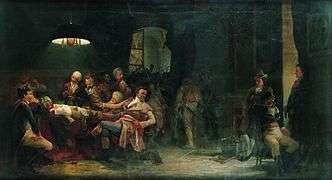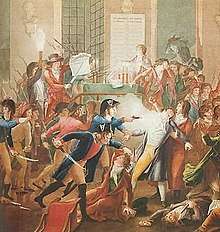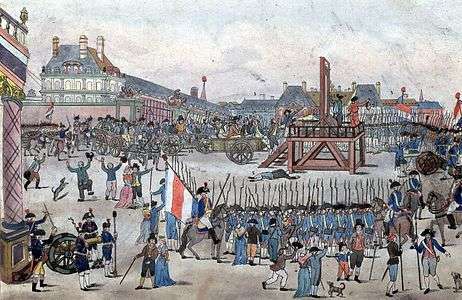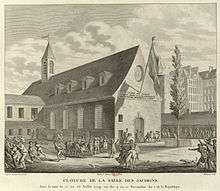Thermidorian Reaction
| Thermidorian Reaction | |||||||
|---|---|---|---|---|---|---|---|
| Part of the French Revolution | |||||||
 Ninth Thermidor by Valery Jacobi | |||||||
| |||||||
| Belligerents | |||||||
|
Thermidorians |
Jacobins
| ||||||
| Commanders and leaders | |||||||
| Strength | |||||||
| Unknown National Guards | c. 3,000 loyalists | ||||||
| Casualties and losses | |||||||
| Unknown |
Various people were executed:
| ||||||
On 9 Thermidor Year II (27 July 1794), the French politician Maximilien Robespierre was denounced by members of the National Convention as "a tyrant", leading to Robespierre and twenty-one associates including Louis Antoine de Saint-Just being arrested that night and beheaded on the following day.
Etymology and definitions
The name Thermidorian refers to 9 Thermidor Year II (27 July 1794), the date according to the French Republican Calendar when Robespierre and other radical revolutionaries came under concerted attack in the National Convention. Thermidorian Reaction also refers to the remaining period until the National Convention was superseded by the Directory; this is also sometimes called the era of the Thermidorian Convention. Prominent figures of Thermidor include Paul Barras, Jean-Lambert Tallien, and Joseph Fouché.
Background
Thermidor represents the final throes of the Reign of Terror. With Robespierre the sole remaining strong-man of the Revolution following the assassination of Jean-Paul Marat (13 July 1793), and the executions of Jacques Hébert (24 March 1794), Georges Danton and Camille Desmoulins (5 April 1794), his apparently total grasp on power became in fact increasingly illusory, especially insofar as he seemed to have support from factions to his right.
His only real political power at this time lay in the Jacobin Club, which had extended itself beyond the borders of Paris and into the country as a network of "Popular Societies". In addition to widespread reaction to the Reign of Terror, Robespierre's tight personal control of the military, his distrust of military might and of banks, and his opposition to supposedly corrupt individuals in government, made him the subject of a number of conspiracies.
Conspiratorial groups
The prime mover for the events of 9 Thermidor (27 July) was a Montagnard conspiracy, led by Jean-Lambert Tallien and Bourdon de l'Oise, which was gradually coalescing, and was to come to pass at the time when the Montagnards had finally swayed the deputies of the Right over to their side. (Robespierre and Saint-Just were themselves Montagnards.)
Many others who conspired against Robespierre did so for strong practical and personal reasons, most notably self-preservation. The surviving Dantonists, such as Merlin de Thionville, wanted revenge for the death of Georges Danton and, more importantly, to protect their own heads. Among the latter were Joseph Fouché and Pierre-Louis Bentabole, who engineered Robespierre's downfall.[1][2]
In the end, it was Robespierre himself who united all his enemies. On 8 Thermidor (26 July) he gave a speech to the Convention in which he railed against enemies and conspiracies, some within the powerful committees. As he did not give the names of "these traitors", all in the Convention had reason to fear that they were the targets. Later, he enlisted the support of the Jacobin Club, where he denounced Collot and Billaud. These men then spent the night planning the following day's coup, with other members of the convention.[3]
Arrest of Robespierre and associates
Conspiracies against Maximilien Robespierre, who had dominated the Committee of Public Safety, came together on 9 Thermidor (27 July) 1794. On that day, in the Hall of Liberty in Paris, Saint-Just was in the midst of reading a report to the Committee of Public Safety when he was interrupted by Jean-Lambert Tallien, member and previously President of the National Convention, who impugned Saint-Just and then went on to denounce the tyranny of Robespierre. The attack was taken up by Jacques Nicolas Billaud-Varenne, also member and previously President of the National Convention, and Saint-Just's typical eloquence failed him, leaving him subject to a withering verbal assault until Robespierre leapt to the defense of Saint-Just and himself. Cries went up of "Down with the tyrant! Arrest him!" Robespierre then made his appeal to the deputies of the Right, "Deputies of the Right, men of honour, men of virtue, give me the floor, since the assassins will not." However, the Right was unmoved, and an order was made to arrest Robespierre and his followers.
Troops from the Paris Commune arrived to liberate the prisoners. The Commune troops, under General Jean-Baptiste Coffinhal, then marched against the Convention. The Convention responded by ordering troops of its own under Paul Barras to be called out. When the Commune's troops heard the news of this, order began to break down, and Hanriot ordered his remaining troops to withdraw to the Hôtel de Ville. Robespierre and his supporters also gathered at the Hôtel de Ville.[4] The Convention declared them to be outlaws, meaning that upon verification the fugitives could be executed within 24 hours without a trial. As the night went on the Commune forces at the Hôtel de Ville deserted until none of them remained. The Convention troops under Barras approached the Hôtel around 2 a.m. on 28 July. As they came, Robespierre's brother Augustin leapt out of a window in an escape attempt, broke his legs, and was arrested. Le Bas committed suicide. Couthon, who due to progressive disease was paralysed from the waist down, was found lying at the bottom of a staircase.[4]

Robespierre was shot in the face, and his jaw was shattered. There are two accounts of how he received the wound. One states that, anticipating his own downfall and wanting to have the death of a hero, Robespierre attempted to kill himself and shattered his own jaw with a shot.[4] The contrary view is that he was shot by one of the Convention's troops. At the time, a gendarme named Charles-André Merda claimed to have pulled the trigger.[5]
Saint-Just made no attempt at suicide or concealment. Hanriot tried to hide in the Hôtel de Ville's yard, by some sources [6] after being thrown out a window into a stack of "latrine product" and hay, but the Convention troops quickly discovered him and assaulted him badly, gouging one of his eyes out so that it hung from its socket.[7]
Deaths of Robespierre and his allies

Robespierre was declared an outlaw, and condemned without judicial process. The following day, 10 Thermidor (28 July 1794), he was executed with twenty-one of his closest associates, including:[8]
- Adrien-Nicolas Gobeau, ex-substitute of the public prosecutor
- Antoine Gency
- Antoine Simon, gaoler of the Dauphin
- Augustin Robespierre
- Charles-Jacques Bougon
- Christophe Cochefer
- Claude-François de Payan
- Denis-Étienne Laurent, municipal officer
- Étienne-Nicolas Guérin
- François Hanriot, ex-commander of the Parisian National Guard
- Jean-Baptiste de Lavalette, ex-général de brigade
- Jean-Barnabé Dhazard
- Jean-Baptiste Fleuriot-Lescot, mayor of Paris
- Jean-Claude Bernard
- Jean-Etienne Forestier
- Jean-Marie Quenet
- Jacques-Louis Frédéric Wouarmé
- Georges Couthon
- Louis Antoine de Saint-Just
- Nicolas-Joseph Vivier, judge of the Revolutionary Tribunal
- René-François Dumas, ex-president of the Revolutionary Tribunal
Aftermath
Consequences
The events of 9 Thermidor proved a watershed in the revolutionary process. The Thermidorian regime that followed proved to be an unpopular one, facing many rebellions after its execution of Robespierre and his allies, along with seventy members of the Paris Commune, the largest mass execution to have ever taken place in Paris.[9] This led to a very fragile situation in France.[10]
The hostility towards Robespierre did not just vanish with his execution. Instead, the people decided to blame those who were involved with Robespierre in any way. Namely, the many members of the Jacobin club, their supporters, individuals suspected of being past revolutionaries and the violent suppression of the sans-culottes by the Muscadin, a group of dandyish street fighters organized by the new government. The massacre of these groups became known as the White Terror.[10]
Often, members of these targeted groups were the victims of prison massacres or put on trial without due process, which were overall similar conditions to those provided to the counter-revolutionaries during the Reign of Terror. At the same time, its economic policies paved the way for rampant inflation. Ultimately, power devolved to the hands of the Directory, an executive of five men who assumed power in France in November 1795 (in year III of the French Revolutionary calendar).[11]
The Thermidorian regime excluded the remaining Montagnards from power, even those who had joined in conspiring against Robespierre and Saint-Just. The White Terror of 1795 resulted in numerous imprisonments and several hundred executions, almost exclusively of people on the political left. These numbers, while significant, were considerably smaller than those associated with the previous Reign of Terror, which killed over 40,000. Many executions took place without a trial.[12]
Thermidorian regime

On July 29 the victor of the 9th Thermidor condemned seventy members of the Paris Commune to death; thereafter the Commune was subject to the Convention.[9]
As part of the reorganization of French politics, practitioners of the terror were called to defend their records; some such as Tallien, Barras, Fouché and Fréron rejoined the leadership. Others such as Billaud-Varenne, Collot d’Herbois, Barère and Vadier were sentenced to exile in South America, though the latter two managed to evade arrest. Many Jacobin clubs were closed. Freedom of worship was extended first to the Vendée and later to all France. On 24 December 1794 the Maximum (controls on prices and wages) was abolished. The government exacerbated this inflationary move by issuing more assignats.
In April and May 1795 protests and riots in support of the radicals broke out culminating in an invasion of the Convention by an insurrectionist mob on 20 May. On 22 May the Convention struck back, having troops under Pichegru surround the Faubourg St-Antoine and force the capitulation of the armed rebels. In May and June 1795, a "White Terror" raged in which Jacobins were victims and the judges were bourgeois "Moderates".[13] Throughout France the events of the September Massacres were repeated, however this time the victims were imprisoned officials of the Terror. In Paris, Royalist sentiments were openly tolerated.
Meanwhile, French armies overran the Netherlands and established the Batavian Republic, occupied the left bank of the Rhine and forced Spain, Prussia and several German States to sue for peace, enhancing the prestige of the Convention. A new constitution called the Constitution of the Year III was drawn up on 22 August 1795, which eased back some of the democratic elements of the constitution of 1793, establishing an electoral college for the election of officials, a bicameral legislature and other provisions designed to protect the current holders of power. On 5 October (13 Vendémiaire), a revolt led by Royalists challenged the Convention. It was put down by Napoleon with a whiff of grapeshot. On 25 October the Convention declared itself dissolved and was replaced by the French Directory on 2 November 1795.
Other Thermidorian reactions
For historians of revolutionary movements, the term Thermidor has come to mean the phase in some revolutions when power slips from the hands of the original revolutionary leadership and a radical regime is replaced by a more conservative regime, sometimes to the point where the political pendulum may swing back towards something resembling a pre-revolutionary state. Leon Trotsky, in his book The Revolution Betrayed, alleges the rise of Joseph Stalin to power was a Soviet Thermidor.
References
- ↑ Stefan Zweig (1930). Joseph Fouché. Viking press. pp. 85–110.
- ↑ Robert Heron, Maurice Montgaillard (comte de), Information concerning the strength, views, and interests of the powers presently at war, Perth, R. Morrison and Son, 1794, p. 205.
- ↑ McPhee. Robespierre: A Revolutionary Life. pp. 271ff.
- 1 2 3 Merriman, John(2004). "Thermidor"(2nd ed.). A history of modern Europe: from the Renaissance to the present, p. 507. W.W. Norton & Company Ltd. ISBN 0-393-92495-5
- ↑ "The French Revolution A History". 2007.
- ↑ Hibbert, Christopher (1982). "The French Revolution, p. 266. Penguin Books, Pearson. ISBN 978-0-140-04945-9
- ↑ Hibbert, Christopher (1982). "The French Revolution, p. 268. Penguin Books, Pearson. ISBN 978-0-140-04945-9
- ↑ Beauchesne, Alcide; Dupanloup, Félix (1868). Louis XVII, sa vie, son agonie, sa mort: captivité de la famille royale au Temple. pp. 218–9.
- 1 2 Will and Ariel Durant, “The Age of Napoleon” (New York:Simon & Schuster, 1975), p. 83.
- 1 2 McPhee, P. (2012). The White Terror, in A Companion to the French Revolution. Oxford: Blackwell Publishing Ltd. doi:10.1002/9781118316399.ch22.
- ↑ Sutherland (2003) ch 8
- ↑ Brown (2010)
- ↑ Will and Ariel Durant, “The Age of Napoleon” (New York:Simon & Schuster, 1975), p. 84.
Further reading
- Bienvenu, Richard, ed. The ninth of Thermidor: the fall of Robespierre (Oxford University Press, 1968)
- Brown, Howard G. "Robespierre's Tail: The Possibilities of Justice after the Terror." Canadian Journal of History (2010) 45#3 online
- Cobban, Alfred. "The Fundamental Ideas of Robespierre," English Historical Review Vol. 63, No. 246 (January 1948), pp. 29–51 JSTOR
- Cobban, Alfred. "The Political Ideas of Maximilien Robespierre during the Period of the Convention," English Historical Review Vol. 61, No. 239 (January 1946), pp. 45–80 in JSTOR
- Durant Will and Ariel Durant. The Age of Napoleon, New York:Simon & Schuster (1975) outdated popular history
- Hibbert, Christopher Paris in the Terror New York: Dorset Press (1981).
- Linton, Marisa. "Robespierre and the Terror", History Today, August 2006, Volume 56, Issue 8, pp. 23–29 online
- Linton, Marisa, Choosing Terror: Virtue, Friendship and Authenticity in the French Revolution (Oxford University Press, 2013).
- McPhee, Peter (2012). Robespierre: A Revolutionary Life. Yale University Press. ISBN 0300118112. ; scholarly biography
- Neely, Sylvia. A Concise History of the French Revolution (2008)
- Palmer, R. R. (1941). Twelve Who Ruled: The Year of Terror in the French Revolution. Princeton University Press. ISBN 0-691-05119-4. A study of the Committee of Public Safety.
- Rudé, George (1976). Robespierre: Portrait of a Revolutionary Democrat. New York: Viking Press. ISBN 0-670-60128-4. A Marxist political portrait of Robespierre, examining his changing image among historians and the different aspects of Robespierre as an 'ideologue', as a political democrat, as a social democrat, as a practitioner of revolution, as a politician and as a popular leader/leader of revolution, it also touches on his legacy for the future revolutionary leaders Vladimir Lenin and Mao Zedong.
- Schama, Simon (1989). Citizens: A Chronicle of the French Revolution. New York: Alfred A. Knopf. ISBN 0-394-55948-7. A revisionist account.
- Scurr, Ruth. Fatal Purity: Robespierre and the French Revolution. London: Metropolitan Books, 2006 ( ISBN 0-8050-7987-4).
- Shulim, Joseph I. "Robespierre and the French Revolution," American Historical Review (1977) 82#1 pp. 20–38 in JSTOR
- Soboul, Albert. "Robespierre and the Popular Movement of 1793–4", Past and Present, No. 5. (May 1954), pp. 54–70. in JSTOR
- Sutherland, D.M.G. The French Revolution and Empire: The Quest for a Civic Order (2003)
- Thompson, James M. (1988). Robespierre. Oxford: Blackwell Publishers. ISBN 0-631-15504-X. Traditional biography with extensive and reliable research.
In French
- Bouloiseau Marc, La republique Jacobin (10 août 1792 – 9 thermidor an II). Paris. (1972)
- Brunel Françoise, Thermidor, la chute de Robespierre, Ed. Complexe (1989).
- Domecq Jean Philippe, Robespierre, derniers temps, Seuil (1984).
- Frère Jean-Claude, Robespierre, la victoire ou la mort, Flammarion (1983).
- Madelin Louis, Fouché, de la Révolution à l'Empire, tome 1, Nouveau Monde Editions, Reedition (2002)
- Mathiez Albert, Autour de Robespierre, Payot.
- Mathiez Albert, Robespierre terroriste, (1921).
- Mathiez Albert, Etudes sur Robespierre, S.E.R. (1927).
- Robespierre Maximilien, Discours et rapports à la Convention, Ed. 10/18 (1965).
- Robespierre Maximilien, Textes choisis, Ed. Sociales (1973).
- Sollet Bertrand, Robespierre, Messidor (1988).